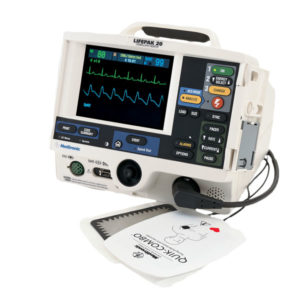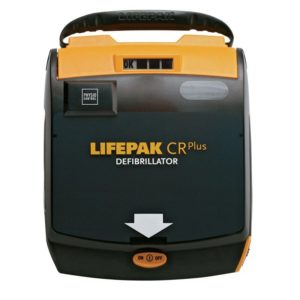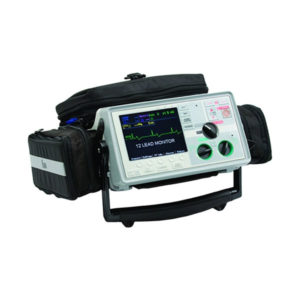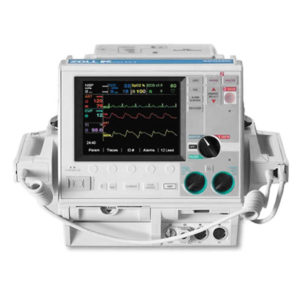Physio Control Lifepak 20e
Certified Refurbished Medical Equipment!
The Physio-Control Lifepak 20 defibrillator/monitor is an acute cardiac care response system used by authorized healthcare providers in hospital and clinical settings
$10,573.50
Lifepak Features
The Physio-Control Lifepak 20e is clinically advanced and packed with power. This Lifepak 20e defibrillator and monitor is highly intuitive for first responders and combines AED and manual capabilities so the ACLS-trained clinicians can quickly and easily deliver advanced therapeutic care. The CodeManagement Module adds waveform capnography and wireless connectivity to enhance your hospital’s ability to effectively manage resuscitations from preparedness through review. The CodeManagement Module adds additional capabilities to the 20e to help aid how your facility manages codes.
Designed for crash cart use, the Physio-Control Lifepak Defibrillator meeds all your defibrillator/monitor needs in a compact and affordable package. The Lifepak is simple yet powerful with special features like capnography, CPR metronome, and the ability to remotely send data to CODE-STAT data review.
Provides quick, effective AED use.
Easily converts to manual mode.
Compact and lightweight for easy carrying and versatile use.
Easy to maintain and service.
Lifepak Specifications
Dimensions
Height: 8.4” (21.3 cm)
Width: 10.3” (26.2 cm)
Depth: 10.3” (26.2 cm)
Weight: 12.3 lbs (5.58 kg)
Display
Size (active viewing area): 115.18 mm (4.53 in) wide x 86.38 mm (3.4 in) high
Resolution: 320 x 240 dot color active LCD. Displays a minimum of 3.7 seconds of ECG and alphanumeric for values, device instructions or prompts Option to display one additional waveform.
Waveform display sweep speed: 25 mm/sec for ECG and SpO2
Power
The device is an AC line operated device with an internal battery as backup.
AC Powered: 100–120 VAC 50/60Hz, 220–240 VAC 50/60 Hz, total power draw less than 120 Volt-Amperes (VA).
Battery
Battery Charge Time: <4 hours when the device is powered off and AC power is applied.
Run Time: A new fully-charged internal backup battery will provide between 110-210 minutes of run time depending on how it’s being used.
Printer
Prints continuous strips of the displayed patient information.
Paper size: 50 mm (2.0 in)
Print speed: Continuous ECG 25 mm/sec +/- 5% (measured in accordance with AAMI EC-11, 4.2.5.2)
Delay: 8 seconds
Autoprint: Waveform events print automatically (user configurable)
Print Speed for CODE SUMMARY Reports: 25 mm/sec
Frequency Response
Diagnostic: 0.05 to 150 Hz or 0.05 to 40 Hz (user configurable)
Monitor: 0.67 to 40 Hz or 1 to 30 Hz (user configurable)
Paddles: 2.5 to 30 Hz
Analog ECG Output: 0.67 to 32 Hz (except 2.5 to 30 Hz for paddles ECG)
Alarms
Quick Set: Activates alarms for all parameters
VF/VT Alarm: Activates continuous CPSS monitoring in Manual Mode
Defibrillator
Waveform: Biphasic Truncated Exponential. The following specifications apply from 25 to 200 ohms, unless otherwise specified.
Energy Accuracy: ±1 joule or 10% of setting, whichever is greater, into 50 ohms ±2 joule or 15% of setting, whichever is greater, into any impedance from 25–100 ohms.
Voltage Compensation: Active when disposable therapy electrodes are attached. Energy output within ± 5% or ± 1 joule, whichever is greater, of 50-ohm value, limited to the available energy which results in the delivery of 360 joules into 50 ohms.
ECG
ECG can be monitored through 3-wire or 5-wire ECG cables.
Standard paddles or therapy electrodes (QUIK-COMBO pacing/defibrillation ECG electrodes or FAST-PATCH disposable defibrillation/ECG electrodes) are used for paddles lead monitoring.
Compatible with LIFEPAK 12 ECG and therapy cables.
Lead Selection
Leads I, II and III, (3-wire ECG cable)
Leads I, II, III, AVR, AVL, and AFV, V (c) acquired simultaneously, (5-wire ECG cable)
ECG size: 4, 3, 2.5, 2, 1.5, 1, 0.5, 0.25 cm/mV
Heart Rate Display: 20–300 bpm digital display
Out of Range Indication: Display symbol “—” Heart symbol flash for each QRS detection
Continuous Patient Surveillance System (CPSS): In AED mode, while Shock Advisory System is not active, CPSS
monitors
the patient via QUIK-COMBO paddles or Lead II ECG for potentially shockable rhythms.
Voice Prompts: Used for selected warnings and alarms (Configurable On/Off)
Analog ECG Output: 1V/mV x 1.0 gain < 35 ms delay
Common Mode Rejection: 90 DB at 50/60 Hz
SpO2
Masimo SET
Additional configuration available for compatibility with select Nellcor sensors
Saturation Range: 1 to 100%
Saturation Accuracy: 70–100% (0–69% unspecified)
Adults/Pediatrics:
+/- 2 digits (during no motion conditions)
+/- 3 digits (during motion conditions)
Neonates:
+/- 3 digits (during no motion conditions)
+/- 3 digits (during motion conditions)
Dynamic signal strength bar graph
Pulse tone at the onset of the pleth waveform
SpO2 Update Averaging Rate: User selectable 4, 8, 12 or 16 seconds
SpO2 Measurement: Functional Sp02 values are displayed and stored
Pulse Rate Range: 25 to 240 pulses per minute
Pulse Rate Accuracy: (Adults/Pediatrics/Neonates)
+/- 3 digits (during no motion conditions)
+/- 5 digits (during motion conditions)
SpO2 waveform with autogain control
Communications
The device is capable of transferring data records by IrDA.
Data Management
The device captures and stores patient data, events (including waveforms and annotations) and continuous ECG waveform records in internal memory.
The user can select and print reports and transfer the stored information.
Report Types
Two format types of CODE SUMMARY critical event record: (short and medium)
Initial ECG (except short format)
Auto vital sign measurements every 5 minutes
Continuous ECG waveform records (transfer only)
Memory Capacity
Two full capacity patient records that include:
Code Summary critical event record – up to 100 single waveform events
Continuous Waveform – 45 minute continuous ECG record.











